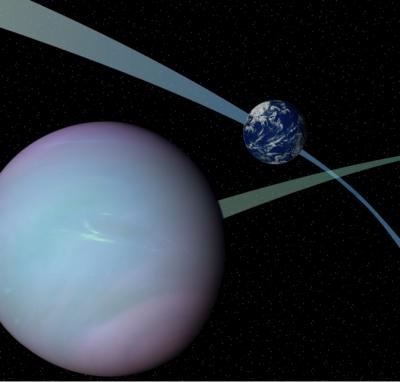Discovery Could Expand Concept Of A World That Could Support Life
Pivoting planets that lean one way and then change orientation within a short geological time period might be surprisingly habitable, according to new modeling by NASA and university scientists affiliated with the NASA Astrobiology Institute.

The climate effects generated on these wobbling worlds could prevent them from turning into glacier-covered ice lockers, even if those planets are somewhat far from their stars. And with some water remaining liquid on the surface long-term, such planets could maintain favorable conditions for life. "Planets like these are far enough from their stars that it would be easy to write them off as frozen, and poor targets for exploration, but in fact, they might be well-suited to supporting life," said Shawn Domagal-Goldman, an astrobiologist at NASA's Goddard Space Flight Center in Greenbelt, MD. "This could expand our idea of what a habitable planet looks like and where habitable planets might be found."
The new modeling considers planets that have the same mass as Earth, orbit a sun-like star and have one or two gas giants orbiting nearby. In some cases, gravitational pulls from those massive planets could change the orientation of the terrestrial world's axis of rotation within tens to hundreds of thousands of years – a blink of an eye in geologic terms.
Though it might seem far-fetched for a world to experience such see-sawing action, scientists have already spotted an arrangement of planets where this could happen, in orbit around the star Upsilon Andromedae. There, the orbits of two enormous planets were found to be inclined at an angle of 30 degrees relative to each other. (One planet was, as usual, farther from the star than the other planet.)
Compared to our solar system, that arrangement looks extreme. The orbits of Earth and its seven neighboring planets differ by 7 degrees at most. Even the tilted orbit of the dwarf planet Pluto, which really stands out, is offset by a relatively modest 17 degrees. "Knowing that this kind of planetary system existed raised the question of whether a world could be habitable under such conditions," said Rory Barnes, a scientist at the University of Washington in Seattle who was part of the team that studied the orbits of the two Andromedae planets.
The habitability concept is explored in a paper published in the April 2014 issue of Astrobiology and available online now. John Armstrong of Weber State University in Ogden, Utah, led the team, which includes Barnes, Domagal-Goldman, and other colleagues.
The team ran thousands of simulations for planets in 17 varieties of simplified planetary systems. The models the researchers built allowed them to adjust the tilt of the planetary orbits, the lean in the axes of rotation, and the ability of the terrestrial planet's atmosphere to let in light. In some cases, tilted orbits can cause a planet to wobble like a top that's almost done spinning – and that wobbling should have a big impact on the planet's glaciers and climate. Earth's history indicates that the amount of sunlight glaciers receive strongly affects how much they grow and melt. Extreme wobbling, like that seen in some models in this study, would cause the poles to point directly at the sun from time to time, melting the glaciers. As a result, some planets would be able to maintain liquid water on the surface despite being located nearly twice as far from their stars as Earth is from the sun.
"In those cases, the habitable zone could be extended much farther from the star than we normally expect," said Armstrong, the lead author of the paper. "Rather than working against habitability, the rapid changes in the orientation of the planet could turn out be a real boon sometimes."
(Image provided by NASA)
 Airborne-Flight Training 05.09.24: ERAU at AIAA, LIFT Diamond Buy, Epic A&P
Airborne-Flight Training 05.09.24: ERAU at AIAA, LIFT Diamond Buy, Epic A&P ANN's Daily Aero-Term (05.07.24): Hazardous Weather Information
ANN's Daily Aero-Term (05.07.24): Hazardous Weather Information Aero-News: Quote of the Day (05.07.24)
Aero-News: Quote of the Day (05.07.24) NTSB Final Report: Cessna 150
NTSB Final Report: Cessna 150 Aero-News: Quote of the Day (05.08.24)
Aero-News: Quote of the Day (05.08.24)



